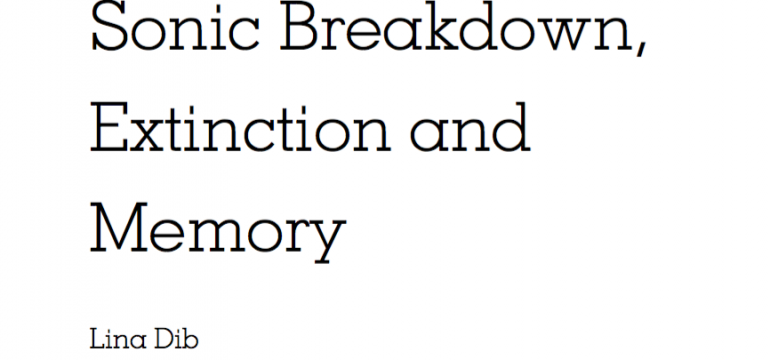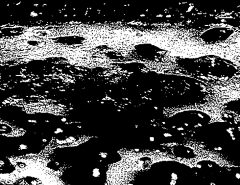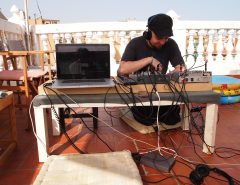Sonic Breakdown, Extinction and Memory by Lina Dib
Originally published in continent.
Download PDF
This soundtrack features sounds of environmental as well as technological extinction. Of course, one cannot speak of extinction without first addressing a breakdown of sorts, a breakdown of what was once sustainable. Restoration ecology seeks to reverse damage brought on to ecosystems by man and seeks to prevent ongoing degradation in order to preserve what is left of our landscapes and their multi-species inhabitants. This repair may be seen as a form of care, an extension of longevity, an attempt to ward off what is beyond repair: extinction. How might technology play a role in the ways we envision repair and extinction? What role does technology play when we find ourselves in a situation beyond repair? How might technology facilitate remembrance? To reflect on these questions, this soundtrack includes sounds of species as well as sounds of technologies that are no longer part of our contemporary sonic entourage but that have acted as sources of environmental destruction, repair and memory.
Sounds of obsolete technologies from steam engines, to dot matrix printers, 16mm projectors and modems, all now functionally extinct, are presented alongside sounds of species either extinct or nearing extinction. Technologies for transcription allow us to hear the haunting, flute-like, mating call of the last Kauai ‘O’O bird (Moho braccatus), recorded circa 1987. This piece also includes the sounds of a Maori man mimicking a Huia bird (Heteralocha acutirostris), native to New Zealand. The Huia is now extinct and there exists no other recording than that of this man imitating its song. Accompanying the Huia is also a recording of a Wood Thrush (Catharus mustelinus), a bird in sharp decline still found in many parts of Northern and Central America. Another threatened species featured in this soundtrack is the Houston Toad (Bufo houstonensis). No longer a resident of Houston, except at the Zoo, its estimated population in its native Texas ranges from 150-300. At the Houston Zoo, Houston Toads are cared for by staff and collaborators who maintain a kind of ‘arc’ for these amphibians. Recently, in 2016, researchers at the Zoo released 775 000 eggs back into the Texas wild to help bolster their dwindling population.
As we enter an age of mass extinction brought on by excesses of industrial production and consumption, this piece invites the listener to reflect on the roles technologies play with respect to biological and environmental extinction. In short, as we listen to these ghosts of the past and sentinels for the future, this soundtrack highlights the importance of thinking temporally across biological and technological fields that both drive continued loss as well as create potential opportunities for repair and remembering.
Special thanks to the The Macaulay Library at the Cornell Lab of Ornithology. The following recordings were used in this soundtrack: 16209, 11308, 56465 and 6049.
_
Lina Dib is a multidisciplinary artist and anthropologist. Her installations and compositions range from the experimental to the ethnographic and investigate socio-technical and ecological change. Dib is an affiliate artist at the Topological Media Lab at Concordia University in Montreal and a research fellow at the Center for Energy and Environmental Research in the Humanities and Social Sciences at Rice University. Her work has been supported by the Andy Warhol Foundation for the Visual Arts, Canada’s Social Science and Humanities Research Council, AMIDA’s European training program, and the Moody Center for the Arts; and has been presented internationally including, Hierarchy Gallery, Washington DC; Lawndale Art Center, Houston; Yerba Buena Gardens, San Francisco; MOP Projects, Sydney; The Museum of Fine Arts Houston; and the Whitney Biennial.





Leave a Reply
Lo siento, debes estar conectado para publicar un comentario.